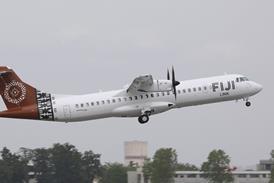Paul Lewis/SINGAPORE
Philippine Airlines (PAL) is drawing up survival plans for a massive shrinkage of its international and domestic operations, after sacking 600 pilots involved in a week-long strike that has brought the national carrier close to financial ruin. Pilots were protesting over plans to force redundancies among older colleagues.
PAL says it intends scaling back operations to a skeleton service of just 14 domestic and four international routes, compared to the 64 operated before the start of the strike on 5 June. The airline is also planning to dispose of at least 20 of its 54-strong fleet of aircraft.
The planned restructuring is a realistic reflection of the level of service the airline is now capable of offering, in the wake of its decision to sack the pilots. PAL is maintaining limited services with management pilots and new recruits.
The airline says that the strike is costing it up to 200 million pesos ($5 million) a day in lost revenue. This is on top of an 8.08 billion peso net loss for the year ending 31 March. PAL is suffering from mounting debt, much of which has been incurred from a $3.2 billion order for 36 new aircraft.
The carrier had already deferred delivery of three Airbus A320s, was negotiating to scrap six of its eight Boeing 747-400 orders and was returning early eight 737-300s leased from General Electric Capital Aviation Services. There are doubts over five more new A320s due this year.
This leaves the airline with five 747-400s, five -200s, eight Airbus A330-300s, eight A340-300s, three A320s, eight A300B4s and 10 Fokker 50s. Given PAL's intention to concentrate on domestic services, the larger and longer range A340s appear most at risk.
Efforts to attract foreign investment and alliance carriers have also been hit. Lufthansa Technik and General Electric Engine Services have been in talks to invest in engineering, while Northwest Airlines has been courted as a partner.
Source: Flight International























